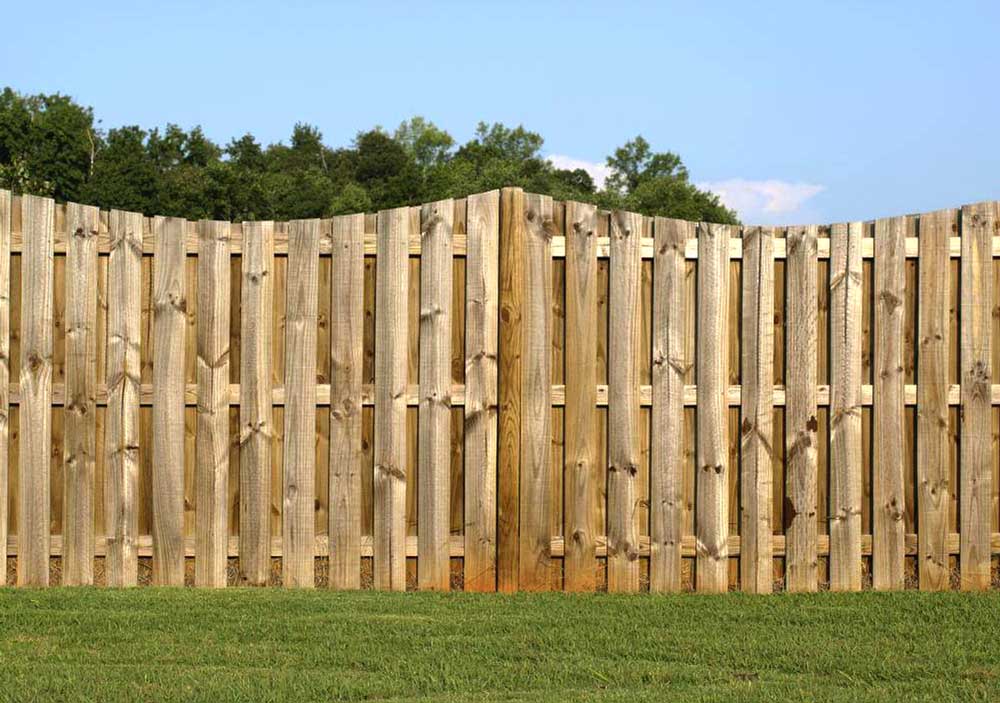The edge of your land is like the line in the sand that shows where your space ends and starts. It’s super important for folks putting up fences to know exactly where this line is. Why? Because not knowing can lead to big-time neighbor drama and might even drag you into court, costing a ton of money. Getting the scoop on where your land ends can save you from a huge headache and keep peace with the folks next door.
You can build a fence either close to or directly on a shared property line. Local fence laws will dictate how close but the typical distance is 4 inches.
Go here to see the fence laws for your state, or speak to a local fencing installer for exact measurements.
Can I build a fence on the property line?
Most fence laws allow homeowners to build their fence on a property line separating them and their neighbor. And also request that your neighbor. On the other hand, you may live in an area where the law requires you to install your fence a few feet from the property line.
More often than not, building on a property line depends on the following:
- The fence laws in your area: local regulations and homeowner’s association (HOA) rules dictate your fence placement options. Review your property deed (if it has one) for the relevant restrictions. You can also check with your HOA for more clarification. More important, you need to read your region’s building and planning laws to make sure you comply.
- Where you reside: installing a fence right on your property line may be allowed in densely populated urban neighborhoods where extra yard space to play and relax makes a huge difference. In contrast, local rules are prone to enable setbacks in the suburbs with large yards.
- Your neighbor’s feelings: neighborly discussions over a perimeter fence can be acrimonious, and your neighbor may balk at the financial implications. Although, several fence laws have provisions addressing this issue. A neighbor’s lack of consent can still stop you from building a fence on the property line if you live in an area where one is required.

Use this FREE service
HomeGardenGuides.com is a free service that quickly matches you with top-voted local fence contractors.
You can get three estimates fast by real certified experts in your area in just 2 minutes.
- Scroll to the top of the page and enter your Zip code.
- Answer questions about your fence project.
- Your project details are forwarded to three local experts. They will send you a price estimate for the job and some friendly advice.
IMPORTANT: There is no obligation to hire. This is a free tool and service to be used at your pleasure.

Will I need a survey to determine the property line?
Conducting a property line survey is a legally binding method of measuring your property’s exact boundaries by hiring a professional surveyor to determine your property’s extent and where your neighbors begin. You can effectively resolve property line disputes without resulting in expensive litigation.
To work out pre-existing property lines, surveyors may have to work with any document you provide. They may also research any historical records relating to your property and work with those. A professional survey can take anywhere from a few hours to a day, depending on the extent of work that needs to be done which may include digging or clearing shrubs.
Survey costs may range from a few hundred to thousands of dollars depending on the following:
- The size of your property.
- The complexities of the survey. For example, land features that add to the survey difficulty.
Please ensure that the surveyor you hire has these two important requirements:
A license to practice in your state where you need the survey done.
B The surveyor must carry professional liability insurance.
Apart from watching the surveyor locate the property line, you can also find it through the following methods:
- Looking at The Property Line Map (PLAT) A plat is a document that is usually part of your property’s paperwork. It shows a detailed scaled rendering of your property and its boundary lines, and for a small fee, you can acquire a copy from the local zoning department.
- By reviewing the property deed. Another way to identify your property lines is by reviewing the deed to your property. A deed is a legal document relating to your property with a written description of its boundaries. If your deed was a recent one without describing your boundary lines, it usually cites an older deed that does. You can obtain a copy of your deed from the register of the deeds office.
- By contacting your current mortgage lender or insurer. More often than not, your mortgage lender and the home insurer have your recent survey on file as it is a requirement for financing and insurance. You can contact either of the two companies for a copy if you don’t have one.
- Dig for survey pins. A survey pin is a narrow metal spike measuring between two to three feet long that the original survey team drove into the ground to mark the property line. Survey pins buried a foot or more below the ground may be more challenging to locate and may require some digging to uncover.
- Search for visible property line markers. More recent properties will have wooden stakes used as property line markers, protruding from the ground. Check to the corners of your property for a visible marker that may be set flush with the ground.
- Through the internet. There are web and mobile applications that allow you to view your property lines online. A typical example is by looking through Geographical Information System (GIS) maps. Also, mobile apps such as LandGlide use GPS to determine your property lines.
Do I need a permit to build a fence?
The general rule across the United States requires you to obtain a permit before building the following fence types.
- A fence that is taller than six feet.
- A masonry fence of any height.
Other types of residential fencing outside the criteria mentioned above do not require a permit, but this depends on your state fence laws. Zonal codes also go further to limit the size of the fence you can build and the places where you may or may not build certain types of fences. For example, most municipalities have the following fence height restrictions:
- A maximum height of 6-feet for a backyard fence.
- A maximum height of 4-feet for a fence fronting a street.
Homeowners who reside in major cities may not be allowed to enclose their property with a barbed-wire fence. Several states have laws banning the use of barbed wire fences outside of farms and rural homesteads.
Do I have to tell my neighbor I’m building a fence?
You have to notify your neighbor if you are building a fence on the boundary line. Fence laws in most states require neighbors on either side of a partitioning fence to share the cost of installing a partitioning fence 50/50. And it is common sense to inform your neighbor if he will be on the hook for half the fence costs.
Laws such as California’s Civil Code Section 841 (Good Neighbors Fence Law) take it a notch higher by making it a legal requirement to give your neighbor 30 days written notice informing him of the following:
- Your intention to build a fence on the property line.
- The fence costs and technical details.
The requirements may differ slightly for your area, and we advise that you check your local codes for more guidance. Also, check out the homegardenguides.com article on Do I Need A Fence Permit? for more information.
Can I build a fence next to my neighbor's fence?
Neighbors who fail to agree on the location or height of a shared fence can install a fence a few feet their side of the property line, leaving a narrow strip of land in-between.
Although building a fence next to each other may have instant
It could lead to long-term issues. The narrow strip of land in-between both fences, also known as “devil’s lane,” can be a source of future maintenance and ownership disputes if a neighbor decides to claim ownership of the land.
FAQ’s
Where can I find property lines for free?
The places where you can find your property lines for free include your property deed and online real estate registers. You can also find your property lines online through Geographical Information System (GIS) maps.
Who gets the good side of the fence?
It is considered good fence etiquette to install the good side of the fence, facing your neighbor. Doing this is not only polite, but it also helps improve relations between both of you.






